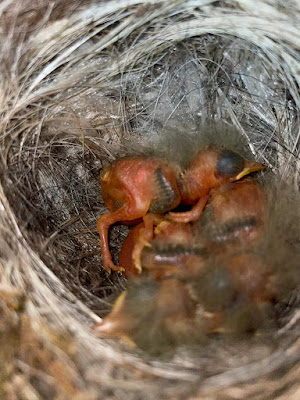It's not often we start our winter sewage works ringing in December, but a couple of weekends of cold weather recently gave us the chance to venture out to a couple of sites.
Gwennap is often our most productive site and a few hours last weekend saw us catch 101 birds, including 59 Chiffchaffs. Of these, just four were birds ringed in previous winters, predictably all at the site. The highlight though was a smart Grey Wagtail which was already carrying a ring, but not one of ours. It had actually been ringed as one of three chicks in a nest in Budock Water in April, 9km from Gwennap.
 |
| The Grey Wagtails in the nest (Sam Pitt Miller) |
This last weekend we were then able to get into Brew sewage works, near Sennen, right down in the far west. It needs a calm day to net this exposed site, so we have to make the most of the chance. A short morning produced 61 birds, of which 45 were Chiffchaffs. Being so close to the autumn ringing site at Nanjizal, several of these were already ringed, which gives a nice insight into the arrival timing of wintering birds (more on that later). Most were from this same autumn, but four were ringed at Nanjizal in autumn 2022, so were returning birds.
Brew is also our best site for Siberian Chiffchaffs (tristis race) of which we caught two, both of which were quite subtle birds (as below), not the cold grey birds we sometimes see.















